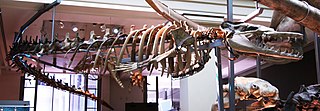
Basilosaurus is a genus of large, predatory, prehistoric archaeocete whale from the late Eocene, approximately 41.3 to 33.9 million years ago (mya). First described in 1834, it was the first archaeocete and prehistoric whale known to science. Fossils attributed to the type species B. cetoides were discovered in the United States. They were originally thought to be of a giant reptile, hence the suffix "-saurus", Ancient Greek for "lizard". The animal was later found to be an early marine mammal, which prompted attempts at renaming the creature, which failed as the rules of zoological nomenclature dictate using the original name given. Fossils were later found of the second species, B. isis, in 1904 in Egypt, Western Sahara, Morocco, Jordan, Tunisia, and Pakistan. Fossils have also been unearthed in the southeastern United States and Peru.

Basilosauridae is a family of extinct cetaceans. They lived during the middle to the early late Eocene and are known from all continents, including Antarctica. They were probably the first fully aquatic cetaceans. The group is noted to be a paraphyletic assemblage of stem group whales from which the monophyletic Neoceti are derived.

Hyaenodon ("hyena-tooth") is an extinct genus of carnivorous placental mammals from extinct tribe Hyaenodontini within extinct subfamily Hyaenodontinae, that lived in Eurasia and North America from the middle Eocene, throughout the Oligocene, to the early Miocene.
Gigantophis is an extinct genus represented by its sole member Gigantophis garstini, a giant snake. Before the Paleocene constrictor genus Titanoboa was described from Colombia in 2009, Gigantophis garstini was regarded as the largest snake ever recorded. It lived about 40 million years ago during the Eocene epoch of the Paleogene Period, in the Paratethys Sea, within the northern Sahara, where Egypt and Algeria are now located.
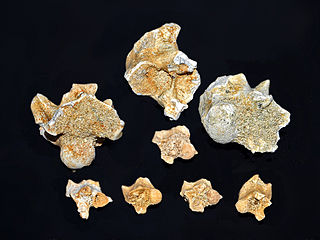
Palaeophis is an extinct genus of marine snake that is the type genus of the extinct snake family Palaeophiidae.
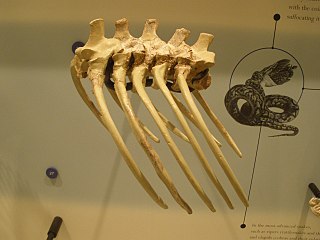
Madtsoiidae is an extinct family of mostly Gondwanan snakes with a fossil record extending from early Cenomanian to late Pleistocene strata located in South America, Africa, India, Australia and Southern Europe. Madtsoiidae include very primitive snakes, which like extant boas and pythons would likely dispatch their prey by constriction. Genera include Madtsoia, one of the longest snakes known, at an estimated 10 metres (33 ft), and the Australian Wonambi and Yurlunggur. As a grouping of basal forms the composition and even the validity of Madtsoiidae is in a state of flux as new pertinent finds are described, with more recent evidence suggesting that it is paraphyletic as previously defined.
Paleontology or palaeontology is the study of prehistoric life forms on Earth through the examination of plant and animal fossils. This includes the study of body fossils, tracks (ichnites), burrows, cast-off parts, fossilised feces (coprolites), palynomorphs and chemical residues. Because humans have encountered fossils for millennia, paleontology has a long history both before and after becoming formalized as a science. This article records significant discoveries and events related to paleontology that occurred or were published in the year 1992.

Iberosuchus is a genus of extinct sebecosuchian mesoeucrocodylian found in Western Europe from the Eocene. Remains from Portugal was described in 1975 by Antunes as a sebecosuchian crocodilian. This genus has one species: I. macrodon. Iberosuchus was a carnivore, unlike the crocodilians today, they are not aquatic and are instead terrestrial.

Quercygale is an extinct genus of placental mammals from extinct family Quercygalidae within clade Carnivoraformes, that lived in Europe during the early to late Eocene. Phylogenetic analysis of the basicranial morphology of carnivoramorphans suggests Quercygale is the most advanced member of clade Carnivoraformes as a sister taxon to crown group Carnivora, predating the split between Feliformia and Caniformia, although another recent study has proposed genus Quercygale should be placed as a stem group within Feliformia.
The Ameki Formation is a Lutetian to Bartonian geological formation located in Nigeria. It belongs to the Bende-Ameki Group, which also consists of two formations namely Nanka Formation, Nsugbe Formation.
Colombophis is an extinct genus of snakes of the clade Alethinophidia, a group of "primitive" snakes. The genus was first recognized in the Villavieja Formation in the town of Los Mangos, part of the known fossil fauna of La Venta in the department of Huila (Colombia), in the middle Miocene. With the remains of a fossil snake was erected the species Colombophis portai in 1977, based on forty fragmentary vertebrae. These vertebrae are characterized by a low neural spine, and subdivided paradiapophysis and thin zygosphene. The vertebrae are medium to large, so the snake would measure about 1.77 metres long, similar in size to the current Boa constrictor.
Eocetus is an extinct protocetid early whale known from the early late Eocene Giushi Formation in Gebel Mokattam, outside Cairo, Egypt. The specimen was first named by Fraas as Mesocetus schweinfurthi. However, the name Mesocetus was previously used causing a change to the species name to Eocetus schweinfurthi. Since the genus was first described in the early 20th century, several other specimens, mostly isolated vertebrae, have been attributed to Eocetus, but the taxonomic status of these widely distributed specimens remain disputed.
Yazoo Clay is a clay geologic formation in Alabama, Louisiana, and Mississippi. It was named after a bluff along the Yazoo River at Yazoo City, Mississippi It contains is a type of clay known as montmorillonite, making it a poor foundation material due to the fact that moisture causes extreme changes in volume. Sand, pyrite, and marl have all been noted in the formation. It preserves fossils from the Eocene, including the prehistoric cetaceans Basilosaurus and Zygorhiza, and the marine snake Pterosphenus. Sharks, rays, eels, and fish have also been found from the formation.

Palaeophiidae is an extinct family of marine snake within the infraorder Alethinophidia.

Coniophis is an extinct genus of snakes from the late Cretaceous period. The type species, Coniophis precedes, was about 7 cm long and had snake-like teeth and body form, with a skull and a largely lizard-like bone structure. It probably ate small vertebrates. The fossil remains of Coniophis were first discovered at the end of the 19th century in the Lance Formation of the US state of Wyoming, and were described in 1892 by Othniel Charles Marsh. For the genus Coniophis, a number of other species have been described. Their affiliation is, however, poorly secured, mostly based on vertebrae descriptions from only a few fossils.
Paraplacosauriops is an extinct genus of anguid lizards from the middle Eocene of France.
The Seca Formation is a Late Eocene geologic formation of the Progreso Basin in southwestern Ecuador. The shales of the formation have provided fossils of the marine snake Pterosphenus sheppardi.
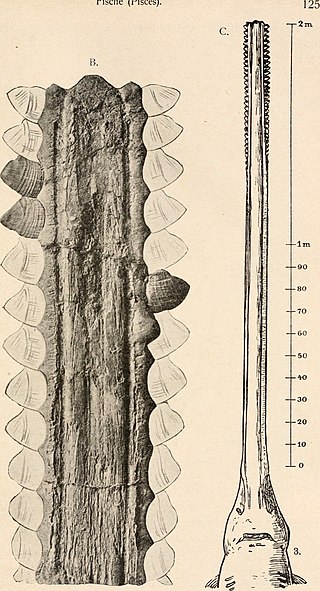
Propristis is an extinct genus of sawfish that lived from the Eocene to the Miocene. It contains two valid species, P. schweinfurthi and P. mayumbensis. It has been found in Egypt, Cabinda, Morocco, Qatar, Spain, the United Kingdom, and the United States. Isolated rostral denticles are the most common remains, but rostra have also been found.
Maliamia is an extinct genus of amiid ray-finned fish from the Early Eocene, known from fragmentary remains found in the Tamaguélelt Formation of Mali. It was described in 1989, based on fossils recovered by three separate expeditions in 1975, 1979–80, and 1981. The type species is Maliamia gigas, named in reference to its large size.
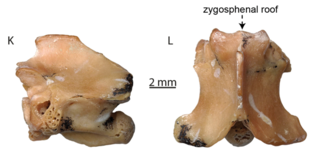
Naja romani is an extinct species of cobra from the Miocene of Europe. Its remains have been found from France to Russia and suggest a continued growth to larger sizes throughout its range in time. While successful during the early and middle stages of the Miocene, the species disappeared from the fossil record of Central Europe during the late Miocene with the last known specimen being recovered from a site in the modern Caucasus, inferred to have been a refuge for reptiles. Estimates suggest that Naja romani may have reached a length of over 2 m.












